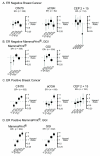Relationship of extreme chromosomal instability with long-term survival in a retrospective analysis of primary breast cancer
- PMID: 21784954
- PMCID: PMC3199437
- DOI: 10.1158/1055-9965.EPI-11-0343
Relationship of extreme chromosomal instability with long-term survival in a retrospective analysis of primary breast cancer
Abstract
Background: Chromosomal instability (CIN) is thought to be associated with poor prognosis in solid tumors; however, evidence from preclinical and mouse tumor models suggest that CIN may paradoxically enhance or impair cancer cell fitness. Breast cancer prognostic expression signature sets, which reflect tumor CIN status, efficiently delineate outcome in estrogen receptor ER-positive breast cancer in contrast to ER-negative breast cancer, suggesting that the relationship of CIN with prognosis differs in these two breast cancer subtypes.
Methods: Direct assessment of CIN requires single-cell analysis methods, such as centromeric FISH, aimed at determining the variation around the modal number of two or more chromosomes within individual tumor nuclei. Here, we document the frequency of tumor CIN by dual centromeric FISH analysis in a retrospective primary breast cancer cohort of 246 patients with survival outcome.
Results: There was increased CIN and clonal heterogeneity in ER-negative compared with ER-positive breast cancer. Consistent with a negative impact of CIN on cellular fitness, extreme CIN in ER-negative breast cancer was an independent variable associated with improved long-term survival in multivariate analysis. In contrast, a linear relationship of increasing CIN with poorer prognosis in ER-positive breast cancer was observed, using three independent measures of CIN.
Conclusions: The paradoxical relationship between extreme CIN and cancer outcome in the ER-negative cohorts may explain why prognostic expression signatures, reflecting tumor CIN status, fail to predict outcome in this subgroup.
Impact: Assessment of tumor CIN status may support risk stratification in ER-negative breast cancer and requires prospective validation.
©2011 AACR
Figures





References
-
- Mcclelland S, Burrell R, Swanton C. Chromosomal Instability, a composite phenotype that determines drug resistance. Cell Cycle. 2009;8 - PubMed
-
- Carter SL, Eklund AC, Kohane IS, Harris LN, Szallasi Z. A signature of chromosomal instability inferred from gene expression profiles predicts clinical outcome in multiple human cancers. Nat Genet. 2006;38:1043–8. - PubMed
-
- Walther A, Houlston R, Tomlinson I. Association between chromosomal instability and prognosis in colorectal cancer: a meta-analysis. Gut. 2008;57:941–50. - PubMed
-
- Kronenwett U, Huwendiek S, Ostring C, Portwood N, Roblick UJ, Pawitan Y, et al. Improved grading of breast adenocarcinomas based on genomic instability. Cancer Res. 2004;64:904–9. - PubMed
Publication types
MeSH terms
Substances
Grants and funding
LinkOut - more resources
Full Text Sources
Other Literature Sources
Medical

